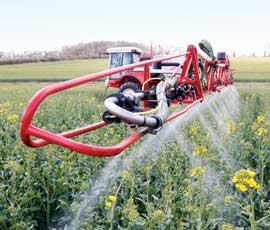Trials show foliar nutrients help boost yields

Applying foliar nutrients to wheat and oilseed rape crops during a dry spring can help crops overcome limited root uptake of key nutrients, thereby boosting yields, according to trial results.
Four years of trials with wheat and three years with oilseed rape across the country have shown average yield responses to foliar nutrients of 0.4t/ha for wheat and 0.2t/ha for oil seed rape, says Chris Bean technical manager at Agrii. The foliar macro-element mix of P, K and magnesium was applied with the normal fungicide T1 spray in wheat and up to late green bud in rape.
But last year, the response in our foliar nutrient trials increased to 0.8t/ha in winter wheat and 0.4t ha in oil seed rape. This was nearly double the response in the previous years trials.” Mr Bean believes the increased response was due to last year’s dry conditions.
For a long period, soils were very dry and the availability of all the micronutrients through the root system was limited,” he says.
Benefits were also seen in soils thought to have adequate P and K. “There were responses on soils with positive P and K balances as well as those deficient in P and K. This suggests crops were unable to take up nutrients in the dry conditions. With soils this spring under moisture stress, and with many soils lacking in P and K, growers should consider using foliar nutrients.”
We have looked at a range of rates, but settled on 2.5litres/ha of a mixture containing (30.5% P, 5.1% K and 5.5% Mg). At these rates it costs around £9/ha to apply,” adds Mr Bean.
In most cases they were applied as part of the tank mix during early fungicide spraying.
Our experience is that the best time for treatment is around T1 timing for winter wheat. Similarly for oilseed rape, we found it most effective to apply around early April or the green bud stage,” says Mr Bean.
Practically, there were few problems with application. “We had no tank mixing issues whatsoever. However, I would advise against mixing with phenoxy herbicides though, as it can have a tendency to flocculate and cause sprayer blockages.”

